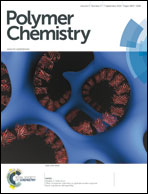Synthesis and characterization of isosorbide-based polyphosphonates as biobased flame-retardants†
Abstract
A new isosorbide-based polyphosphate was synthesized and applied as a flame-retardant for polylactic acid (PLA). The storage modulus and glass transition temperature of PLA/polyphosphonate blends was unaffected by the inclusion of polyphosphonate, but moderate depressions of PLA's tensile strength (16%, 28%, and 45% reduction from PLA at a polyphosphonate mass percentage of 5%, 10%, and 15%, respectively) and strain-at-break (0%, 17%, and 30% reduction from PLA at a polyphosphonate mass percentage of 5%, 10%, and 15%, respectively) were observed. Modified UL-94 flammability testing indicated that isosorbide-based polyphosphonates are effective flame retardants for PLA and are able to self-extinguish flames in less than 2 s to achieve V2 and V0 ratings at polyphosphonate mass percentage of 5% and 15%, respectively. Fire test data indicates a gas phase mechanism that can quench the flame when no external radiant heat flux is present (e.g., in modified UL-94 testing) but does not affect the material's heat release rate in forced combustion (e.g., in cone calorimetry). Use of the biobased flame retardants described herein yields flame retardant PLA containing up to 97% by mass of bio-derived content.


 Please wait while we load your content...
Please wait while we load your content...